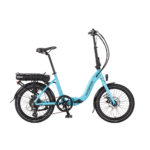Up to now I`ve set my bikes up more or less to the standard Sheldon Brown method where he states " if you can touch the ground whilst on the saddle then you have your saddle too low"
Well, I`ve been doing some adjustments after experiencing aches in the knees and for me I think that a slightly lower saddle height than he suggest seems to suit me better and take away the aches.
For instance, I was out on my Evans conversion bike this afternoon and on that bike I can just about touch my toe on the ground when I stop, I`ve done the other leg stretch exercise down to the pedal to obtain the right height. Today after about 5 miles my knees where aching so I stopped and dropped my saddle 1/2" and the rest of the ride went fine. To all intent the height I now have my saddle set up is too low but it works for me.
Has anyone else got any views on the subject? or agrees or disagrees with the standard method of setting the height?
Well, I`ve been doing some adjustments after experiencing aches in the knees and for me I think that a slightly lower saddle height than he suggest seems to suit me better and take away the aches.
For instance, I was out on my Evans conversion bike this afternoon and on that bike I can just about touch my toe on the ground when I stop, I`ve done the other leg stretch exercise down to the pedal to obtain the right height. Today after about 5 miles my knees where aching so I stopped and dropped my saddle 1/2" and the rest of the ride went fine. To all intent the height I now have my saddle set up is too low but it works for me.
Has anyone else got any views on the subject? or agrees or disagrees with the standard method of setting the height?






